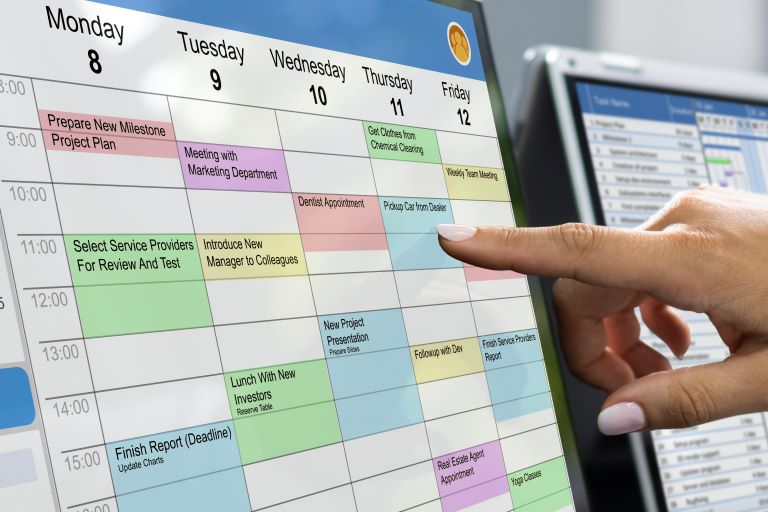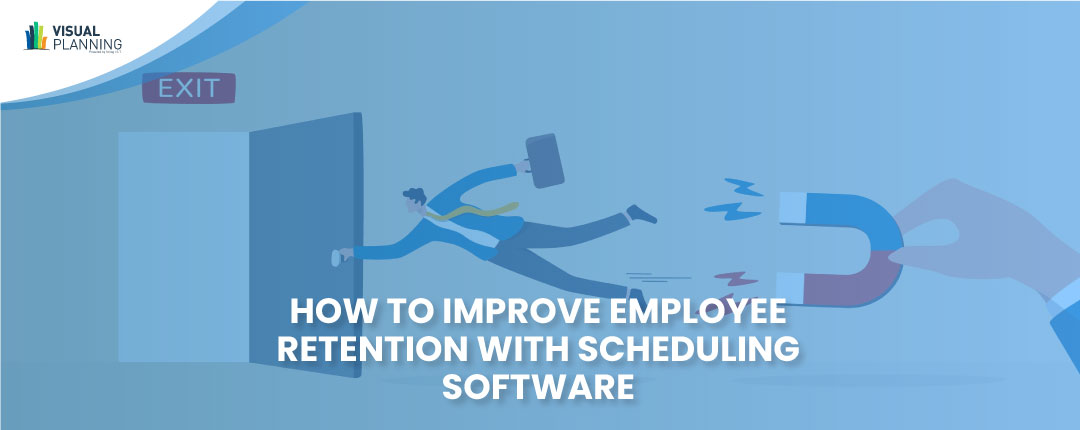Businesses may wonder how to improve employee retention. Employee retention is a critical issue for businesses of all sizes. High turnover rates can not only be costly but can also impact overall productivity and morale within an organization. One effective solution to this problem is the use of scheduling software. By implementing the right scheduling software, businesses can improve employee retention rates and create a positive work environment. In this article, we will explore the importance of retention, the benefits of using scheduling software, and the different types of scheduling software that can enhance motivation and retention.
Why is Retention Important?

Retention is essential for several reasons. First and foremost, it reduces the costs associated with recruiting, hiring, and training new employees. By focusing on retention, businesses can significantly reduce these financial burdens and allocate resources more efficiently.
Furthermore, high employee turnover rates can disrupt workflow and create gaps in knowledge and expertise within an organization. Employees take valuable institutional knowledge and experience that cannot be easily replaced when they leave. This loss of ability can lead to decreased productivity and increased errors as new employees need help to fill the gaps left behind. By prioritizing retention, businesses can foster a sense of stability and continuity within their workforce, ensuring that essential knowledge and expertise are retained.
In addition to cost savings and knowledge retention, retaining employees can increase productivity and customer satisfaction. Employees who feel valued and supported are likely to be engaged and motivated. This can result in higher productivity as employees go the extra mile to achieve their goals and contribute to the organization’s success.
Moreover, satisfied employees are more likely to provide exceptional customer service when comfortable and committed to their jobs. A happy and engaged workforce translates into better customer experiences, leading to higher customer retention rates. Satisfied customers are more likely to become loyal advocates for the business, spreading positive word-of-mouth and attracting new customers. Ultimately, this can improve the bottom line and long-term business success.
Benefits of Enhanced Employee Retention

Enhancing employee retention has numerous benefits for businesses. One of the key advantages is the preservation of institutional knowledge. Employees who stay with a company for an extended period accumulate valuable experience and insights that can contribute to overall organizational success.
High retention levels can create a positive work environment where employees feel engaged, motivated, and satisfied. This, in turn, can result in higher employee morale and reduced stress. Employees who are happy in their jobs are less likely to seek employment elsewhere.
Another benefit of enhanced retention is the development of solid relationships between employees and management. Over time, employees who remain with a company can establish trust and rapport with their superiors. This can lead to open lines of communication, increased job satisfaction, and a greater sense of belonging.
Consider a manufacturing company where employee retention is a priority. The management team regularly meets with employees to understand their needs, concerns, and career aspirations. This proactive approach builds trust and fosters a sense of loyalty among employees. As a result, employees feel valued and supported, leading to improved job satisfaction and a higher likelihood of staying with the company for the long term.
Types of Scheduling Software that Can Improve Retention and Motivation
Several different types of scheduling software can improve retention and motivation. These include:
-
-
- Employee scheduling software
- Production scheduling software
- Resource scheduling software
-
Employee Scheduling Software

Employee scheduling software is designed to streamline the process of creating schedules for employees. This software provides an efficient way to assign shifts, manage time-off requests, and ensure proper coverage. Employees feel more in control of their work-life balance by having access to their schedules in advance and the ability to make requests conveniently. This sense of power leads to increased satisfaction and improved retention.
Furthermore, employee scheduling software offers additional benefits that contribute to employee motivation. For example, it allows employees to view their upcoming shifts, breaks, and tasks, which helps them plan their personal lives accordingly. This level of transparency fosters trust between employees and management, ensuring everyone is on the same page regarding work expectations.
Production Scheduling Software

Production scheduling software plays a crucial role in employee retention in industries where production processes are involved. This software helps plan and manage the production process, including assigning tasks, monitoring progress, and ensuring timely completion. Production scheduling software reduces stress and improves job satisfaction by providing employees with clear expectations and realistic deadlines.
Additionally, production scheduling software often incorporates features that allow employees to track their progress and performance. This data can be used for performance evaluations and recognition, boosting employee engagement and motivation. When employees clearly understand their role in the production process and receive credit for their contributions, they are more likely to feel valued and committed to their work.
Resource Scheduling Software

Resource scheduling software is particularly beneficial for organizations that rely heavily on shared resources, such as meeting rooms, equipment, or vehicles. By implementing resource scheduling software, businesses can avoid conflicts, optimize resource utilization, and ensure that employees have access to the necessary tools and facilities when needed. This leads to increased efficiency, reduced frustration, and improved retention.
Moreover, resource scheduling software often includes features that allow employees to request and reserve resources readily. This eliminates manual coordination and reduces the chances of double bookings or misunderstandings. When employees have a seamless experience accessing shared resources, they can focus more on their work and feel supported by the organization.
How Scheduling Software Can Boost Employee Retention
Employee retention is critical to any successful business. High turnover rates can be costly and disruptive, decreasing productivity and increasing recruitment expenses. There are many ways to retain employees. One effective tool businesses can use to improve retention is scheduling software. Not only does scheduling software streamline the process of creating and managing employee schedules, but it also offers several features that can enhance employee satisfaction and engagement.
Encourage Participation and Engagement

One way scheduling software improves retention is by encouraging employee participation and engagement. For example, some scheduling software allows employees to request preferred shifts or swap shifts with colleagues through an intuitive interface. When employees have a say in their schedules, they feel valued and empowered, increasing job satisfaction and retention.
By involving employees in the scheduling process, businesses also create a sense of ownership and accountability. When employees actively participate, they are likely to show up on time, be reliable, and take their responsibilities seriously. This fosters a positive company culture and strengthens employee loyalty.
Furthermore, scheduling software can offer additional features such as shift bidding, where employees can bid on available shifts based on their preferences or seniority. This gives employees more control over their schedules and promotes healthy competition and motivation.
Create Routine Schedules
Scheduling software enables businesses to create schedules that provide employees with predictable work patterns. This is particularly important for staff who rely on consistent programs to maintain a work-life balance, such as those with childcare responsibilities or secondary jobs.
By offering routine schedules, employers demonstrate their commitment to employee well-being and make it easier for employees to plan their personal lives. This reduces stress and increases job satisfaction, contributing to higher retention rates.
Moreover, scheduling software can automatically generate schedules based on predefined templates, considering factors such as employee availability, skill sets, and workload distribution. This not only saves time for managers but also ensures fair and balanced scheduling practices.
Easily Plan for Deadlines

Scheduling software helps businesses plan and manage project deadlines effectively. By visualizing tasks, milestones, and deadlines clearly and organized, employees can prioritize their work and allocate sufficient time for each task. This eliminates last-minute rushes and the associated stress, improving job satisfaction and better employee retention.
In addition, scheduling software can integrate with project management tools, allowing employees to align their schedules with project timelines and deliverables seamlessly. This synchronization ensures that employees have a comprehensive overview of their responsibilities and can plan their work accordingly, resulting in increased productivity and reduced employee burnout.
Receive and Implement Feedback Directly From Employees
An essential feature of scheduling software is the ability to receive feedback directly from employees. This could include requests for schedule changes, suggestions for improvement, or even comments on workload and job satisfaction. By creating a channel for open communication, employers can gain valuable insights and address concerns promptly.
Employees who feel heard and valued are likely to stay with a company. Their feedback can help shape policies and scheduling practices that improve satisfaction and retention rates. Additionally, scheduling software can provide analytics and reporting features, allowing managers to identify patterns and trends in employee feedback, further enhancing decision-making processes.
In conclusion, scheduling software offers numerous benefits that can significantly contribute to employee retention. Businesses can foster a positive work environment that encourages loyalty and satisfaction by promoting participation and engagement, creating routine schedules, facilitating effective deadline planning, and enabling direct employee feedback. Investing in scheduling software is a strategic move that streamlines scheduling processes and enhances overall employee retention and organizational success.
Start Improving Retention with Visual Planning

If you are wondering how to improve employee retention and motivation, Visual Planning is a powerful tool that can help. By implementing the right scheduling software solution, businesses can create a more positive work environment, reduce turnover costs, and increase overall productivity.
Whether through employee, production, or resource scheduling, the benefits are clear. Empowering employees, creating routine schedules, effectively planning for deadlines, and receiving employee feedback is crucial to boosting retention.
Don’t let employee retention be an ongoing challenge. Explore the possibilities of scheduling software and start improving retention in your organization today. Request a demo.
Visual Planning is available on premise or in the cloud. Find out more about all Visual Planning features here, or read our case studies to understand how we are helping many companies to leverage their inner strengths.
Communicator Journalist with an Organizational Communication master degree specialized in Digital Communication from Jean Moulin Lyon 3 University. Passionate about new technologies, social medias, marketing and cooking.



